How to Avoid Rejection of Fingerprints
Services by Forensic Professionals
How to Avoid Rejection of Fingerprints
Understanding the RCMP Fingerprint Comparison Process
Before diving into the causes of fingerprint rejection by the Royal Canadian Mounted Police (RCMP), it’s essential to understand how digital fingerprints are processed and compared for obtaining a Certified Criminal Record Check.
When your digital fingerprints are transmitted to the RCMP, they are compared against the National Repository of Criminal Records to determine if there is a “match” or “no match” with the existing fingerprint data.
The Fingerprint Comparison Process
Contrary to common belief, the fingerprint comparison process is not as simple as identifying general patterns like loops, whorls, arches, or double loops. While these patterns are unique to individuals, they are not sufficient alone to determine a match because:
•Fingerprint Patterns Are Common: Similar patterns can appear in millions of people.
•Minutiae Data is Key: The comparison relies on detailed ridge characteristics and distinguishing minutiae points, such as bifurcations, ridge endings, and enclosures, which are unique to each fingerprint.
The Role of AFIS
With advancements in technology, the Automated Fingerprint Identification System (AFIS) has revolutionized the fingerprint matching process, enabling:
•Fast and efficient comparison of millions of fingerprints within minutes.
•High accuracy, provided the submitted fingerprints are of sufficient quality.
However, even with AFIS, the success of the comparison depends on whether the submitted fingerprints are “clear enough” to extract usable minutiae data.
What Does “Clear Enough” Mean?
For fingerprints to be successfully compared, they must contain:
1. Sufficient Ridge Details: The fingerprint must include distinguishable ridge characteristics and minutiae points.
2. Proper Quality and Clarity: Blurred, smudged, or incomplete fingerprints may lack the required minutiae data for comparison.
In summary, while technology has improved the speed and efficiency of fingerprint matching, the clarity and quality of submitted fingerprints remain critical. Poor-quality fingerprints can result in rejection, highlighting the importance of professional fingerprinting services to ensure successful submissions.
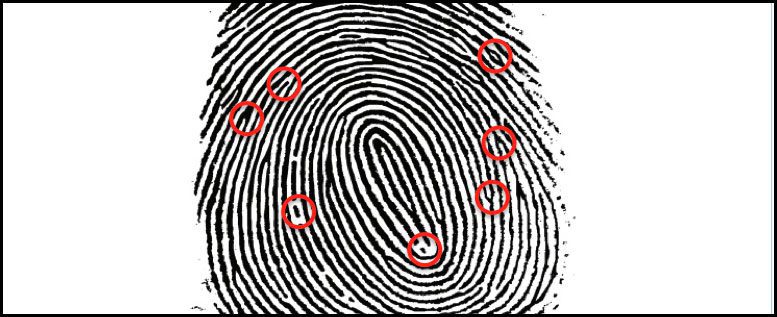
The above photomicrograph shows ridges (in black) and furrows (in white). Minutiae or ridge characteristics are the deviations (bifurcations, ridge-endings, eye-lets, short ridges, ridge dots, etc.) from the normal ridges (shown with red circles). These minutiae are in fact compared to find out if two fingerprints match or do not match.
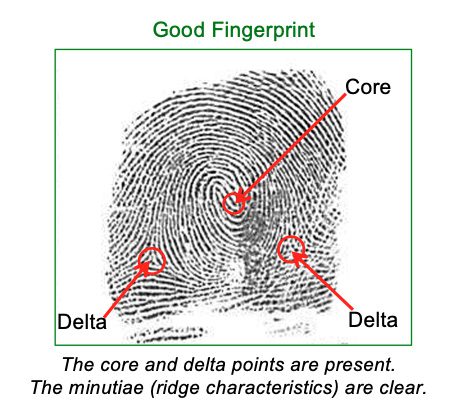
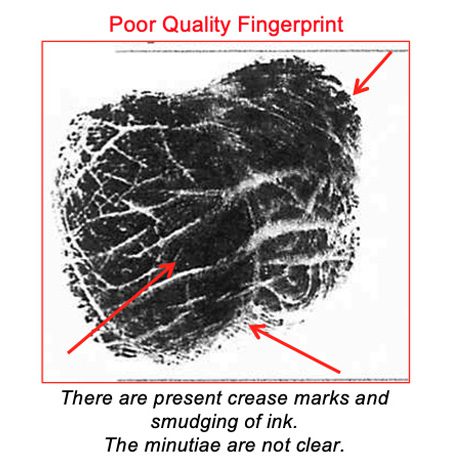
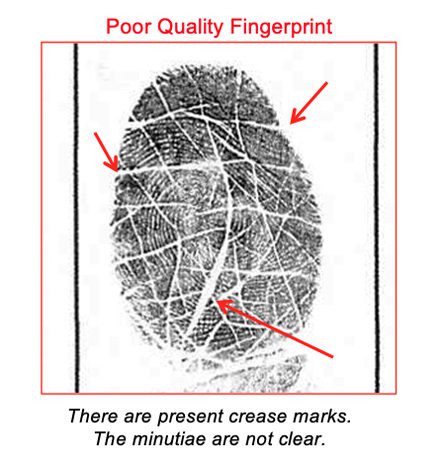
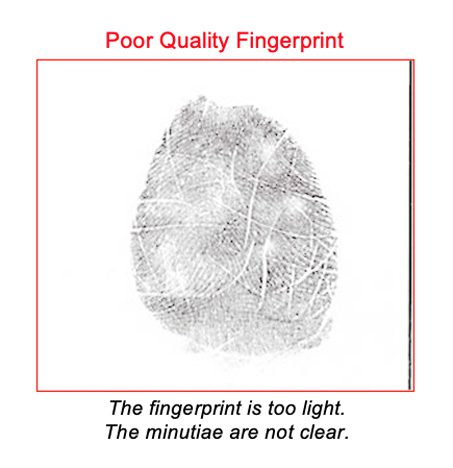
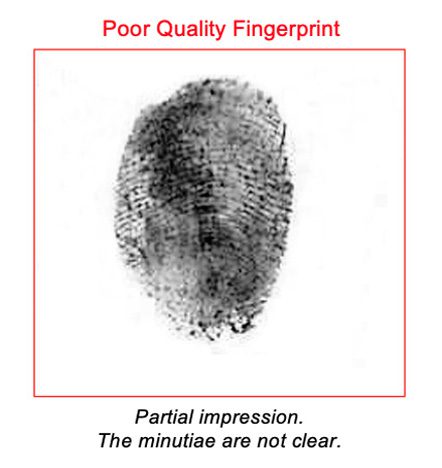
Common causes of low-quality fingerprints
Common Causes of Unclear Fingerprints
Unclear fingerprints, which may result in rejection by the RCMP, can arise due to various physical or technical factors, including:
Physical Causes
1. Skin Conditions: Crease marks, scars, cuts, or excessively dry skin.
2. Sweaty or Dry Hands: Excessive moisture or dryness affecting fingerprint clarity.
3. Worn Fingerprint Ridges: Due to age, type of work, or exposure to harsh chemicals (e.g., bleach, chlorine, acetone).
4. Medical Conditions: Conditions that alter skin texture or ridge patterns.
5. Missing or Amputated Fingers: Missing digits or physical limitations impacting the ability to capture prints.
Technical Causes
1. Excessive Ink Application: Over-inked prints result in smudging.
2. Insufficient Ink Application: Light or incomplete prints where the entire fingertip isn’t covered.
3. Poor-Quality Ink: Low-grade ink leading to unclear impressions.
4. Improper Pressure: Uneven pressure during fingerprinting causing distorted prints.
5. Improper Rolling Technique: Rolled impressions not captured correctly from nail to nail.
6. Partial Prints Taken: Incomplete impressions that fail to meet RCMP standards.
How to Avoid Rejections
• Ensure hands are clean and dry before fingerprinting.
• Rely on trained professionals to guarantee proper inking and rolling techniques.
• Use high-quality ink and equipment to capture clear impressions.
• For individuals with worn ridges or scars, inform the technician to apply special care.
By addressing these factors, you can significantly reduce the chances of fingerprint rejection and ensure a smooth processing experience.
Possible Solutions
Tips for Ensuring High-Quality Fingerprints
For Worn Ridges, Dry Hands, or Wrinkles
• Moisturize Regularly: Apply a good moisturizer, such as O’Keeffe’s Working Hands cream, for 8-10 days before your appointment to improve skin condition.
• Hydrate Skin: Focus on keeping hands hydrated, particularly in dry or cold weather.
For Sweaty Hands
• Wipe Frequently: Keep a towel handy to wipe hands during fingerprinting.
• Cool and Dry: Rinse hands with cold water and dry them thoroughly before the process.
If Fingerprints Show Smudging
• Reduce Pressure: Lighten the pressure during fingerprinting to avoid dark, smeared prints.
• Use Proper Ink: Ensure high-quality fingerprinting ink is used, not stamp pads or cheap inks, which often lead to smudging.
If Fingerprints Are Too Light
• Choose Darker Ink: Request better-quality, darker ink for clearer ridge details.
• Avoid Dried-Out Ink: Ensure fresh, high-quality ink is available for optimal results.
For Worn-Out Fingerprints (e.g., Due to Age)
• Use Live-Scan Technology: Live-scan devices produce higher-quality images and allow for retakes if needed, ensuring the best possible prints.
If Skin Condition Is Affected by Work or Chemicals
• Take a Break: Minimize hand sanitizer use, frequent washing, or handling chemicals a few days before your appointment.
• Protect Hands: Use gloves or other protective measures to reduce skin damage.
Choose the Right Technician
• Find a Trained Professional: Ensure the technician is skilled in fingerprinting and uses a live-scan device for superior results.
• Assess Quality During the Appointment: If the technician seems inexperienced or uses subpar techniques, consider finding another provider to avoid rejections and delays.
Why Choose Worldwide Forensic Services Inc.
Among the accredited fingerprinting agencies in Canada, Worldwide Forensic Services Inc (WWFS) is the only fingerprinting agency run by forensic professionals having over 37 years of experience in examining and taking fingerprints.
In case your fingerprints are not clear, we can help you and guide you to a better fingerprinting process. In case fingerprints get rejected, we even offer free resubmission of fingerprints to the RCMP.
We offer an option to email a scanned copy of the fingerprint form for review. This option saves lots of time.
Walk-in Location
Worldwide Forensic Services Inc.
55 Town Centre Court
Suite 642
Toronto (Scarborough)
ON M1P 4X4 Canada
Business Hours:
Mon-Fri 09:00 am-05:00 pm
Saturday 10:00 am-05:00 pm
Ph: 416-915-7139
Email: info(at)canadianpolicecheck.ca
How Can We Help?
Please send us a quick message and we will get back to you as soon as possible.

